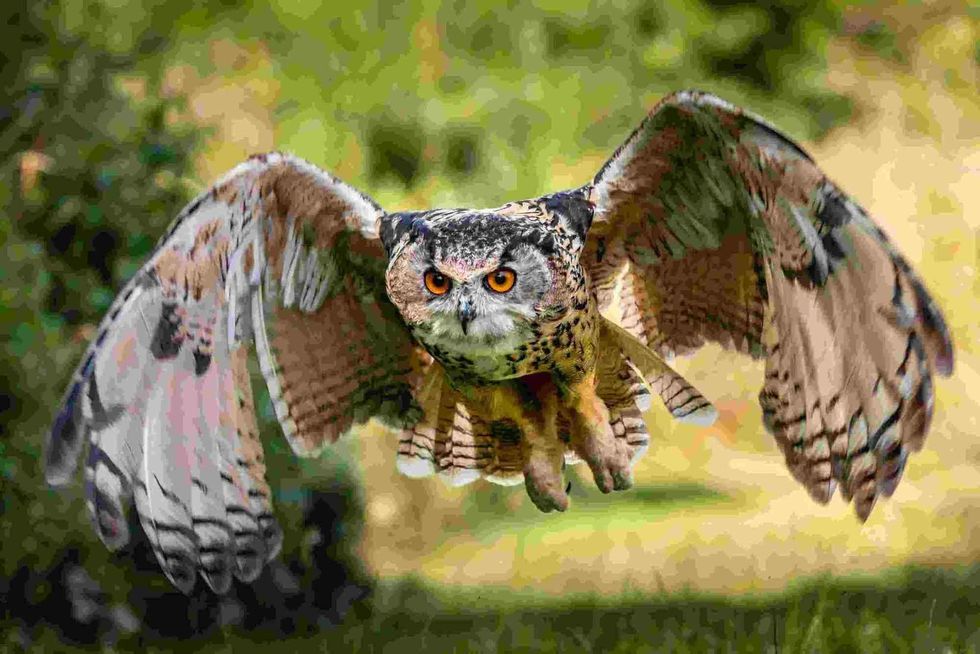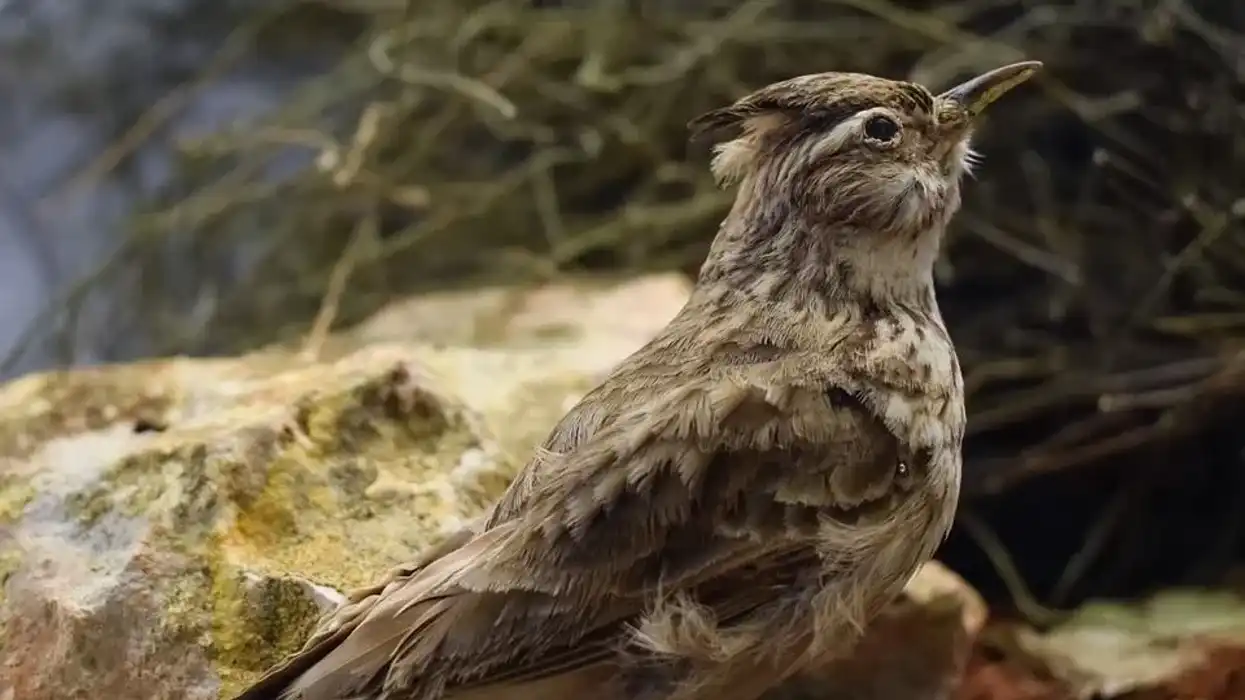Eurasian eagle-owls are birds of prey found in elevated terrains, including coniferous forests, mountainous regions, and rocky areas in North Africa, the Middle East, Europe, and Asia. These raptors are nocturnal creatures and depend on their incandescent orange eyes for extended night vision.
They are also known by their scientific name, 'Bubo bubo'.
The Eurasian eagle-owl Bubo bubo is arguably the largest among owl species, with a bodyweight of up to 10.1 lb (4.6 kg). They have prominent ear tufts on their head with feathers above their ears, giving their appearance the illusion of having feathered horns.
Despite an expansive wingspan of almost 6 ft (180cm), the Eurasian eagle-owl is a surprisingly quiet flier. For this, it uses shallow wing beats and long glides for a graceful and relatively soundless flight.
Also, the feathers on its wings have a soft fringe, further reducing the sounds generated when it flies. It is these distinct characteristics that give the Eurasian eagle-owl its powerful nickname of being a 'silent hunter'.
At Kidadl, you can discover several other owls and fascinating birds of prey, including the sea eagle, and the barn owl.
Eurasian Eagle Owl Interesting Facts
What type of animal is a Eurasian eagle-owl?
A Eurasian eagle-owl, Bubo bubo, is a bird of prey, much like eagles and vultures.
What class of animal does a Eurasian eagle-owl belong to?
Like all birds, the Eurasian eagle-owl belongs to the class Aves.
How many Eurasian eagle-owls are there in the world?
The exact count is unknown, though experts estimate a wide population range, being between 250,000 and 2.5 million. Their numbers are reducing due to disturbance and loss of habitat, hunting, and poaching by humans. But as of date, these birds have a strong presence on three continents, namely, Africa, Europe, and Asia.
Where does a Eurasian eagle-owl live?
Eurasian eagle-owls are found in elevated terrains, including mountainous regions, rocky areas, wooded areas like coniferous forests, deserts, and river beds. This adaptability has helped them survive on a massive range, spanning 12 million square miles, across three continents (Asia, Africa, and Europe).
What is a Eurasian eagle-owl's habitat?
The Eurasian eagle-owl, Bubo bubo can live in a widespread habitat of elevated terrains, including mountain regions, rocky areas, wooded coniferous forests, and even in the desert! They avoid areas with extreme conditions like the Arctic tundra.
They are solitary creatures that prefer to live up in the trees during the day and hunt powerfully but quietly during the night.
Who do Eurasian eagle-owls live with?
Eurasian eagle-owls are solitary creatures who are mostly happy in their own company! The exception to this rule is seen during their mating season during late fall in the U.S. when they actively seek out their chosen mates.
How long does a Eurasian eagle-owl live?
They have an average life span of 20 years when living in the wild. The oldest wild specimen that was found from this species, was estimated to be almost 28 years. In contrast, they triple their life span when they are in managed captivity like zoos, with some birds surviving up to 68 years.
How do they reproduce?
A Eurasian eagle-owl achieves sexual maturity before it is two years old. But it may hold on for another year before it seeks out a mate, so it can establish its own home territory. This is useful for nesting.
In the wild, Eurasian eagle-owl are known to be monogamous, mating with the same partner all their life. Changes in this behavior have been observed when in managed care.
Female birds are bigger than their male counterparts. They mate during the end of fall around December and begin to nest in January.
During this time, the male owls become aggressive about their territory and actively call out to their partner through vocal noises like staccato and clucking sounds. It is also the male’s responsibility to create nests, preferably in mountainous regions including cliff ledges, cave entrances, and rock crevices.
The female lays a clutch of up to four white eggs every year, and the eggs hatch at different intervals. The responsibility of incubation lies solely with female owls, while male owls go out to hunt and gather food for the family.
Young owl chicks become capable of eating on their own by the time they are three weeks old.
They begin to take their first hesitant steps in flight when they are 60 days old. They are also forced to leave the nest and live on their own before they turn one year old.
What is their conservation status?
The official status of the Eurasian eagle-owl is of Least Concern. They have a wide, expected population range, between 250,000 and 2.5 million.
This is also considered the most widely distributed owl species, with a strong presence in at least three continents. These eagle-owls are found in North Africa, Middle East, Europe, and Asia. So they are also considered the largest living owl species that presently resides on our planet.
Eurasian Eagle-Owl Fun Facts
What do Eurasian eagle-owl look like?

Eurasian Eagle Owls are large birds with a striking appearance. They occur in a variety of earthy colors, including the common black-brown, brown-black, and tawny buff color combinations.
The Eurasian eagle-owl has a barrel-like physique with a dark and spotted upper frame and a shallow facial disc that is barely noticeable. These raptors have a barred tail, and strong, black feet with sharp talons, ideal for catching their prey.
For a bird species, Eurasian eagle-owls are powerful creatures, weighing up to 10.1 lb (4.6 kg). They have strong black legs with pointed talons and a barred tail.
Their barred wings are a spectacular sight to behold when in flight with a sweeping wingspan that ranges between 4-6 ft (1.2-1.8 m). Finally, the Eurasian eagle-owl is also characterized by its luminous orange eyes, responsible for its clear vision at night. It is this distinct trait that helps these birds become mighty effective night hunters.
How cute are they?
The Eurasian eagle-owl is indeed cute, but only when it is safely viewed, from a distance, or in managed care. The Eurasian eagle-owl provides a spectacular visage when in flight, with an expansive wingspan of 4-6 feet (120-180cm).
It also has piercing orange eyes that give it the famous night vision. But these owls can get aggressive and attack when they perceive strangers in close proximity.
How do they communicate?
Eurasian eagle-owls communicate through a range of loud hoots, clucks, and growl sounds. Each sound communicates a distinct need.
How big is a Eurasian eagle-owl?
The Eurasian eagle-owl can weigh up to 10.1 lb (4.6 kg) and is twice the size of a pigeon.
How fast can a Eurasian eagle-owl fly?
These birds are made for fast flying, with a wide wingspan of 4-6 ft (120-180 cm). Owls fly at an average speed of 20 mph (32 kph) even during pitch-dark night.
How much does a Eurasian eagle-owl weigh?
A Eurasian eagle-owl is arguably considered among the largest in owl species, weighing between 2.6-10.1 lb (1.2–4.6kg). It can lift three times its weight.
What are the male and female names of the species?
Both males and females are simply called Eurasian eagle-owls.
What would you call a baby Eurasian eagle-owl?
A baby Eurasian eagle-owl is called an owlet or a chick.
What do they eat?
Eurasian eagle-owls are nocturnal birds of prey and feed on a carnivorous diet of rodents like rats, mice, and voles, and rabbits, lizards, and fish. For this, their bright orange eyes help with night vision.
The fringe on their feathered wings further reduces the sounds produced during their night flight. Together, these traits help these birds become powerful night hunters.
When it is young and small in size, the Eurasian eagle-owl can be vulnerable to bigger birds of prey, like the golden eagle. In fact, a mother owl goes out of her way to hide and protect her chicks. As they grow, they become less susceptible to predators.
Are they dangerous?
Yes, they can be dangerous. Eurasian eagle-owl attack humans and predators like foxes and other birds of prey, if they get too close to their young ones.
They can also leave fatal wounds with their pointed beaks and sharp talons. But these attacks are more in defense than in offense. These birds are carnivorous but mostly feed on rodents and rabbits.
Eurasian eagle-owls are also less dangerous than their American counterpart, the great horned owl. Great horned owls are feared predators, as they are very much capable of killing humans.
Would they make a good pet?
No, Eurasian eagle-owls do not make good or safe pets. If they perceive a threat to their young ones, or even themselves, they will not hesitate to use their sharp talons to inflict potentially fatal wounds!
These are also large birds with sharp claws, and can cut off your finger in mere seconds using their pointed beak!
While Eurasian eagle-owls are bred in managed captivity, it is best to leave their care and supervision to certified experts. It is, however, possible to own a Eurasian eagle owl in the United States.
Did you know...
The prominent ear tufts of the Eurasian eagle-owls are sometimes mistaken for ears. But their ears are actually small, asymmetrical holes on their head. Despite their small size, owl ears have powerful sensors that are used to detect their food and predators while they hunt at night.
The Eurasian eagle-owl's strength
Eurasian eagle-owls are deservedly considered the most powerful owl species. With their strong legs and barrel-like body, they can lift things that are twice their body weight, that is up to 18 lb (8.2 kg).
Why is the Eurasian eagle-owl endangered?
While the official conservation status of this species is Least Concern, the population of Eurasian eagle-owls is on the decline as it is endangered. This is due to the following reasons, loss and disturbance of habitat by increased urbanization that encroaches forest land.
Vulnerability of eggs and owlets to predators as adult eggs are known to abandon them to save themselves. Hunting and poaching by humans.
Fortunately, these raptors have a wide home range for their survival. They are also being consciously bred in managed care to increase their population numbers.
Here at Kidadl, we have carefully created lots of interesting family-friendly animal facts for everyone to discover! For more relatable content, check out these hummingbird facts and tawny owl facts for kids.
You can even occupy yourself at home by coloring in one of our free printable Eurasian Eagle-owl coloring pages.









